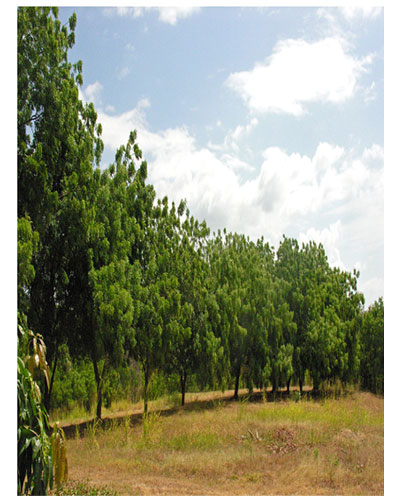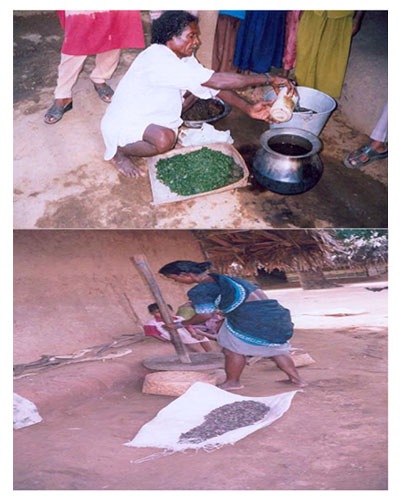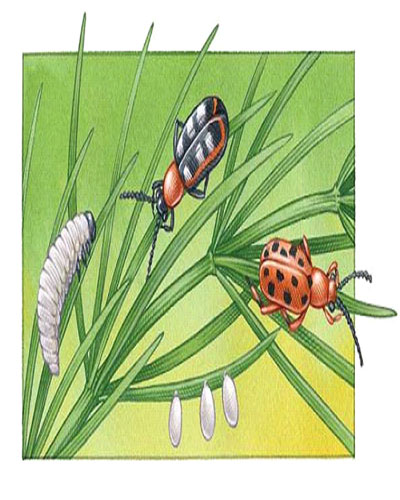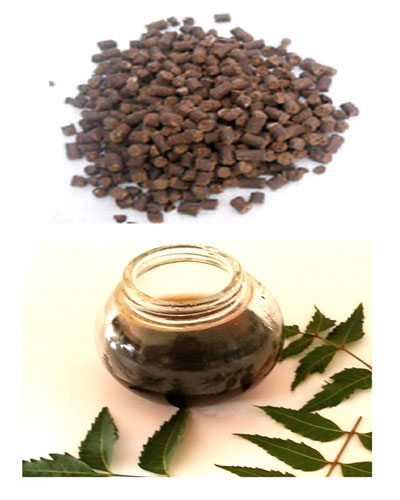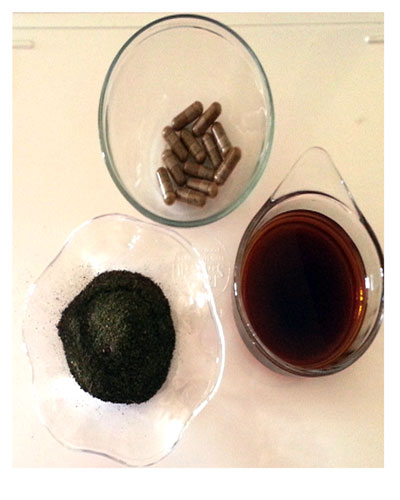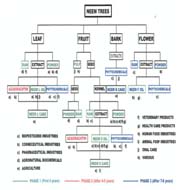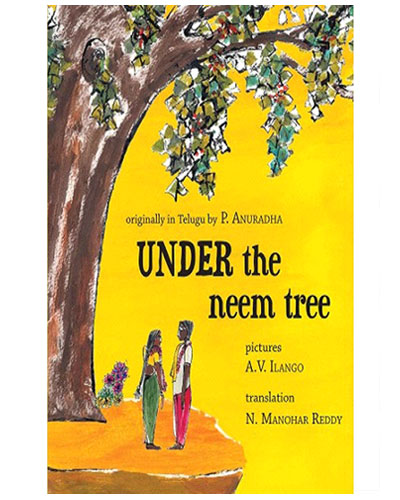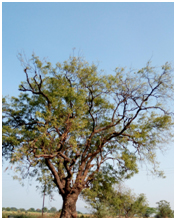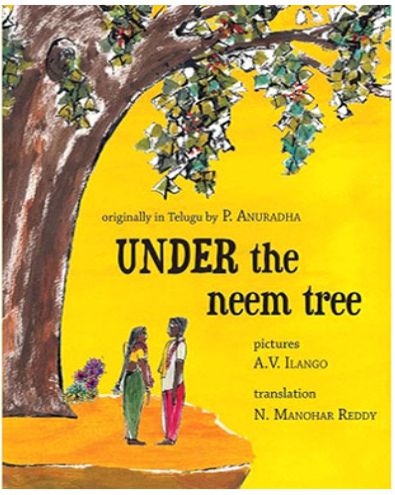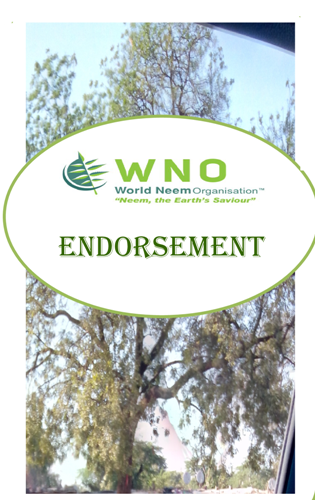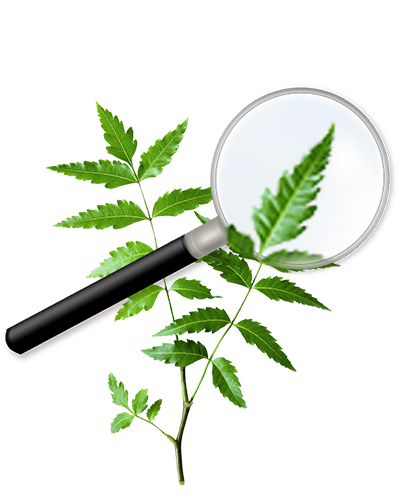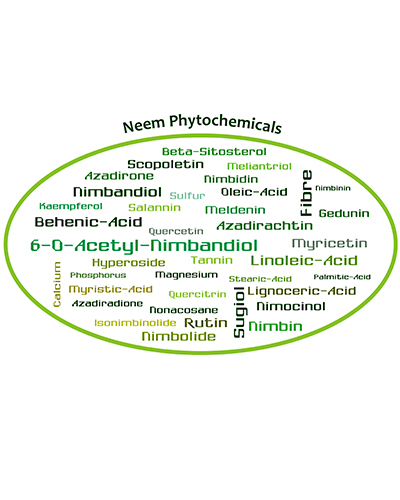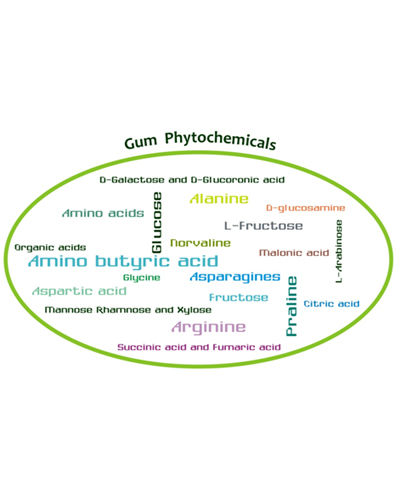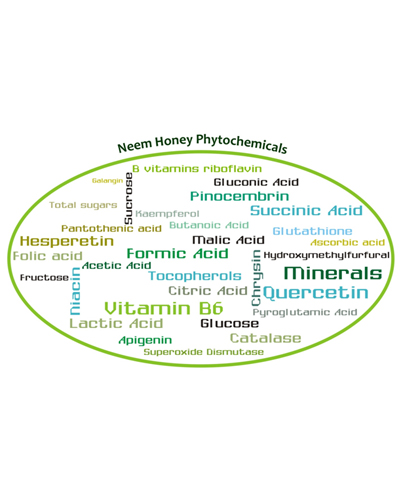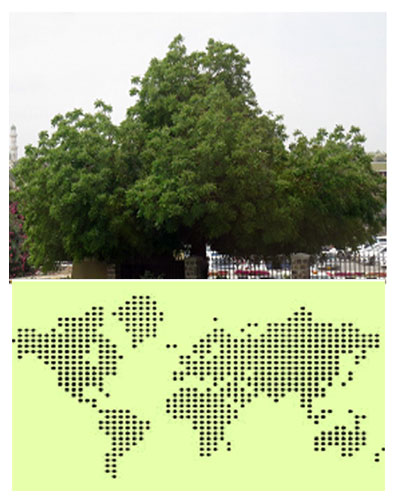Bitter & Sweet Neem Flowers – A Review
The flowering season of Neem tree varies from place to place. Generally it flowers from January to May. The flowers are 5 mm-long, pentamerous, small, and White or pale yellow, scented, numerous on long axillary panicles.
Flower buds open in the afternoon and evening producing a strong scent at night. The flowers have a sweet jasmine-like fragrance and produce ample quantities of nectar.
Neem flowers contains the essential oil, Nimbosterol, flavonoids and phenolic compounds Rutin, Quercetin, Kaempferol, Kaempferol-3-glucoside(Astragalin), Myricetin, β-sitosterol, Quercetin-3-galactoside(Heparin or Hyperoside), β-sitosterol-β-D-Glucoside, and Melicitrin, limonoid Nimbolide, Fatty acids Behenic acid, Archidic acid , Stearic , Palmitic , Oleic and Linoleic acid, Amino acids Glutamic acid, Tyrosine, Arginine, Methionine, Phenylalanine, Histidine, Arminocaprylic acid and Isoleucine.
Neem flowers have a variety of uses. Uses of Neem Flowers are in:
Food Industry: Neem flowers are used as condiments and for food flavouring. They are bitter unless cooked. Neem flowers are known for improving digestive health and are used in Indian cooking. Neem flowers are available in fresh, dry or powder form. They are roasted, boiled and fried for use in sauces and rice dishes. Neem honey, also used in cooking, is extracted from Neem flowers. They’re often dry baked and sprinkled for dish garnish as well.
Aromatherapy: Neem flower oil and extracts are used in aromatherapy. Aromatherapy practitioners consider Neem flower oil as an essential oil due to its calming and relaxing effect on the body. Thus Neem flower oil is useful in calming the mind and body.
Cosmetic Industry: Used as an astringent in facial creams.
Pharmaceutical Industry: Flowers are used in drugs and wound dressings.
Traditionally, Neem was used in Ayurveda for a number of conditions. Neem flowers are used for the elimination of intestinal worms, phlegm, and bile suppression. Neem flowers can be used to treat anorexia, nausea, belching. Practitioners of alternative medicine also mix Neem flowers with other parts of the Neem tree to treat blood problems, leprosy, itching and other skin conditions. The flowers are traditionally used as an element tonic for the treatment of fever and nasal polypus’s.
Use fresh Neem flowers to lose weight naturally which is safe and good. Neem flowers are helpful in weight loss. Neem flowers improve the metabolic rate of the body. As a result, the rate of burning calories and reducing fat also increases. According to Mrs. T.Radha et al, 2019, the Neem flowers are dried, aged for months, fried and ingested to improve eyesight and treat digestive disorders.
Research Review
Study done by Kusamran WR et al in 1998, clearly demonstrated that Neem flowers contain monofunctional phase II enzyme inducers and compounds capable of repressing some monooxygenases, especially those involved in the metabolic activation of chemical carcinogens. Purohit and Daradka, in 1999 reported that Neem flowers caused hypolipidemic effects when administered to rabbits.
Kusamran WR et al, 2002 found that Neem flowers contain some Chemopreventive agents capable of inhibiting AFB1 and DMBA induced liver and mammary gland carcinogenesis in female Sprague-Dawley rats.
Kusamran WR et al in 2005 showed that Nimbolide is a known phytochemical present in Neem leaves, was found for the first time in the flowers too. Both nimbolide and chlorophylls strongly enhanced the level of QR mRNA in Hepa 1c1c7 cells, as monitored by northern blot hybridization, indicating that the mechanism by which these constituents of neem flowers induced QR activity is the induction of QR gene expression. These findings may have implication on cancer Chemopreventive potential of Neem flowers in experimental rats previously reported.
According to Molay Kumar Roy et al, 2007 Nimbolide, a triterpenoid extracted from the flowers of the Neem tree (Azadirachta indica), was found to have antiproliferative activity against some cancer cell lines. The antiproliferative effect of nimbolide and its apoptosis-inducing property raise hope for its use in anticancer therapy by enhancing the effectiveness of cell cycle disruption.
Neem flower has antifertility activity. It can be used as an antifertility agent. Study done by SC Gbotolorun et al in 2008 demonstrated that alcoholic extract of Neem flowers alters the estrous cycle, by prolonging the duration of the diestrum phase and subsequently lowering the frequency at which the oestrus phase occurs. Consequently the frequency of ovulation is reduced and fertility may therefore be impaired.
Worarat Chaisawangwong and Wandee Gritsanapan in 2009 reported that the Neem flower extract has exhibited in vitro free radical scavenging activity and can inhibit lipid peroxidation of bronchogenic cancer cell line.
The investigation done by Abhishek S. Shah et al.,2009 suggests that aqueous extract of Azadirachta indica flowers may stimulate both specific and non specific immune responses by stimulating macrophages, humoral and cell mediated response. It can therefore be concluded that aqueous extract of Azadirachta indica flowers is a potential immunostimulant against cytotoxic drugs and can be used as a complimentary therapeutic agent.
K Indumathi, 2011 reported that there was a statistically highly significant improvement in the health status of the pre-school children with the worm infestation after the Neem flower powder use. Administration of Neem flower is simple and easy to implement, easily available, no notable side effects and reduces the degree of worm infestation among pre-school children. This finding supported that the Neem flower powder administration among pre-school children is the best intervention to treat worm infestation.
A study done by Narsing Rao, G et al, 2014 revealed that the Neem flower powder could be a good source of lipid with polyunsaturated fatty acids such as oleic, Linoleic, Linolenic and few unconventional fatty acids. The volatile oil has characteristic flavour from Caryophyllene. The flower powder exhibited higher DPPH radical scavenging activity and iron reducing power. These results are encouraging for proposing in vivo animal studies for determining the physiological activities of Neem flower extracts for their application in food and pharmaceutical industries. The large quantities of Neem flowers are wasted during flowering season every year.
Acharaporn Duangjai et al, 2019 showed that A. indica flower extract has cholesterol-lowering effects by inhibiting intestinal cholesterol absorption, interfering micellar cholesterol formation, and attenuating cholesterol synthesis. The data indicated a vital role for A. indica in cholesterol-lowering treatment; however, further in vivo study is needed to validate its hypocholesterolemic effects in humans. A. indica flower extract has potential for developing into Nutraceuticals product for prevention of hypercholesterolemia.
Study done by Xin Cui et al, 2019 showed that Nimbolide, a triterpenoid isolated from flowers of Neem tree possesses various therapeutic properties. The results of the study show that nimbolide treatment has markedly enhanced health and reduced inflammation via lessening the proinflammatory cytokines expression in arthritic rats. Hence, nimbolide may be used as a potent therapeutic drug in treating rheumatoid arthritis.
As per the results of the study done by Mrs. T.Radha et al, 2019, flowers of Neem plant contain good antibacterial activity. The extract of Neem flower had been tested for their antibacterial activities and an interesting antibacterial profile has been observed against gram positive (Bacillus subtilis) and gram negative bacteria (Escherichia coli). Work revealed that Neem flowers are rich in cholesterol so the soap prepared by these Neem flowers will contain sufficient fat content and due to its antibacterial activity will keep skin safe and healthy.
References:
Abhishek S. Shah, Mahendra A. Gunjal, Archana R. Juvekar; Immunomostimulatory activity of aqueous extract of Azadirachta indica flowers on specific and non specific immune response; Journal of Natural Remedies ; Vol. 9/1 (2009) 35 – 42
Acharaporn Duangjai, Atcharaporn Ontawong1,2, and Chutima Srimaroeng; Siamese neem flower extract suppresses cholesterol absorption by interfering NPC1L1 and micellar property in vitro and in intestinal Caco-2 cells; Research in Pharmaceutical Sciences, June 2019; 14(3): 190-200
Hathaitip Sritanaudomchai, Thanit Kusamran, Worapun Kuakulkiat, Nuntavan Bunyapraphatsara, Ankana Hiransalee, Anong Tepsuwan, Wannee R Kusamran; Quinone Reductase Inducers in Azadirachta Indica A. Juss Flowers, and Their Mechanisms of Action; Asian Pac J Cancer Prev . Jul-Sep 2005; 6(3):263-9
Gbotolorun S.C., Osinubi A.A., Noronha C.C., Okanlawon A.O.; Antifertility potential of Neem flower extract on adult female Sprague-Dawley rats; African Health Sciences, Vol 8 No 3, September 2008
K. Indumathi; Effectiveness of Neem Flower powder for Worm Infestation in Pre-school Children (3-6 Yrs) in selected villages at Cheyyur Taluk; A Dissertation submitted to The Tamil Nadu Dr. M.G.R. Medical University, Chennai; In partial fulfilment of the requirement for the degree of Master of Science in Nursing, March 2011.
Kusamran WR, Ratanavila A, Tepsuwan A. Effects of Neem flowers, Thai and Chinese gourd fruits and sweet basil leaves on hepatic monooxygenases and glutathione S-transferase activities, and in vitro metabolic activation of chemical carcinogen in rats; Food Chem Toxicol 1998; 36: 475-484.
Purohit A, Daradka HMM; Hypolipidaemic effects of Neem flower in Rabbits ;Department of Zoology, J.N.V. University, Jodhpur, 1999; pp 146-148.
Molay Kumar Roy, Masuko Kobori, Makiko Takenaka, Kazuhiko Nakahara, Hiroshi Shinmoto, Seiichiro Isobe, Tojiro Tsushida; Antiproliferative effect on human cancer cell lines after treatment with nimbolide extracted from an edible part of the neem tree (Azadirachta indica ), Phytotherapy Research, 2007; Volume 21, Issue 3
Narsing Rao, G., Prabhakara Rao, P. G. and Satyanarayana, A; Chemical, fatty acid, volatile oil composition and antioxidant activity of shade dried Neem (Azadirachta Indica L.) flower powder; International Food Research Journal 21(2): 807-813 (2014)
Tepsuwan A, Kupradinum P, Kusamran WR; Chemopreventive potential of Neem flowers on carcinogen induced rat mammary and liver carcinogenesis; Asian Pac J Cancer Prev 2002; 3: 231-238.
T Radha, G Karthikeyan, S Sindhujaa, S Kavipriya; Phytochemical screening and Antibacterial activity of Neem flower (Azadirachta indica) and Production of Homemade Soap; International Advanced Research Journal in Science, Engineering and Technology , December 2019; Vol. 6, Issue 12, December 2019
Worarat Chaisawangwong and Wandee Gritsanapan; Extraction method for high free radical scavenging activity of Siamese neem tree flowers; Songklanakarin J. Sci. Technol;31 (4), 419-423, Jul. - Aug. 2009
Xin Cui, Ruijing Wang, Peimin Bian, Qingke Wu, Vidya Devanatha Desikan Seshadri & Lun Liu; Evaluation of antiarthritic activity of nimbolide against Freund’s adjuvant induced arthritis in rats; Artificial Cells, Nanomedicine, and Biotechnology, 2019; 47:1, 3391-3398,
Dr Nirrmala Kotharii
Director & General Secretary, World Neem Organisation
Managing Director, Neem Wave Exhibitions LLP


